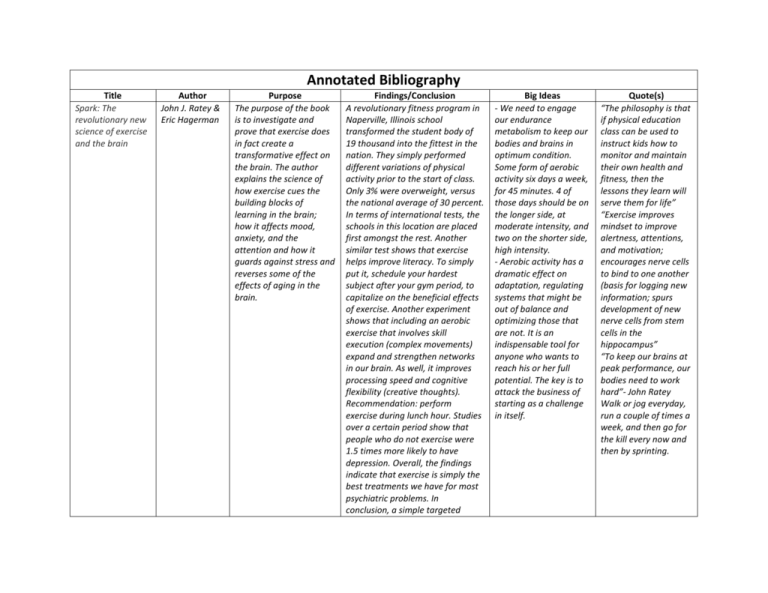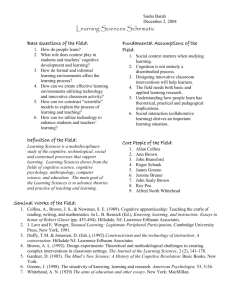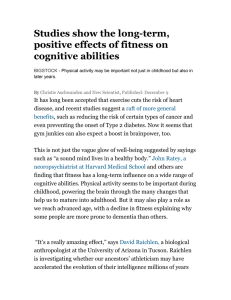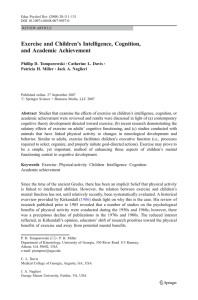Annotated-Bibliography
advertisement

Annotated Bibliography Title Spark: The revolutionary new science of exercise and the brain Author John J. Ratey & Eric Hagerman Purpose The purpose of the book is to investigate and prove that exercise does in fact create a transformative effect on the brain. The author explains the science of how exercise cues the building blocks of learning in the brain; how it affects mood, anxiety, and the attention and how it guards against stress and reverses some of the effects of aging in the brain. Findings/Conclusion A revolutionary fitness program in Naperville, Illinois school transformed the student body of 19 thousand into the fittest in the nation. They simply performed different variations of physical activity prior to the start of class. Only 3% were overweight, versus the national average of 30 percent. In terms of international tests, the schools in this location are placed first amongst the rest. Another similar test shows that exercise helps improve literacy. To simply put it, schedule your hardest subject after your gym period, to capitalize on the beneficial effects of exercise. Another experiment shows that including an aerobic exercise that involves skill execution (complex movements) expand and strengthen networks in our brain. As well, it improves processing speed and cognitive flexibility (creative thoughts). Recommendation: perform exercise during lunch hour. Studies over a certain period show that people who do not exercise were 1.5 times more likely to have depression. Overall, the findings indicate that exercise is simply the best treatments we have for most psychiatric problems. In conclusion, a simple targeted Big Ideas - We need to engage our endurance metabolism to keep our bodies and brains in optimum condition. Some form of aerobic activity six days a week, for 45 minutes. 4 of those days should be on the longer side, at moderate intensity, and two on the shorter side, high intensity. - Aerobic activity has a dramatic effect on adaptation, regulating systems that might be out of balance and optimizing those that are not. It is an indispensable tool for anyone who wants to reach his or her full potential. The key is to attack the business of starting as a challenge in itself. Quote(s) “The philosophy is that if physical education class can be used to instruct kids how to monitor and maintain their own health and fitness, then the lessons they learn will serve them for life” “Exercise improves mindset to improve alertness, attentions, and motivation; encourages nerve cells to bind to one another (basis for logging new information; spurs development of new nerve cells from stem cells in the hippocampus” “To keep our brains at peak performance, our bodies need to work hard”- John Ratey Walk or jog everyday, run a couple of times a week, and then go for the kill every now and then by sprinting. Be smart, exercise your heart: Exercise effects on brain and cognition. Charles H. Hillman, Kirk I. Erickson and Arthur F. Kramer The articles purpose is to examines the positive effects of aerobic physical activity on cognition and brain function, at the molecular, cellular, systems and behavioural levels. The research with humans is mostly focused on the effects of exercise on cognitive processes, as assessed with paperand-pencil and computer-based tests. Exercise and Cognitive Function: Time Course of the Effects Simon Cooper, Stephan Bandelow, Maria Nute, John Morris, Mary Nevill The purpose of this article was to perform a study that was to was to assess the time course (10 and 60min postexercise) of the effects of 15min intermittent exercise (in cycles of 1 min exercise, 30s rest). A battery of computer based cognitive function tests (Stroop test, regimen to get your body moving and your mind in peak condition will change your approach in life. - Human research strongly supports the positive effects of exercise on cognition: aerobic activity improves learning and task acquisition, increases secretion of key neurochemicals associated with synaptic plasticity and promotes neuronal architecture development. - Studies have indicated that an increase in the amount of time dedicated towards physical healthbased activities (such as physical education) is not accompanied by a decline in academic performance. - In conclusion, there is converging evidence at the molecular, cellular, behavioural and systems levels that physical activity participation is beneficial to cognition. - Findings of the present study suggest that the relationship between exercise-cognition in children is mediated by both the time of cognitive testing relative to exercise and the component of cognitive function examined. - Specifically, adolescent’s performance levels were slower but more accurately on the Stroop test (assessing attention) 10min post-exercise, as well slower 10min - Exercise has an effect on the hippocampus as this is were memories are formed, which is vital for learning. For learning to occur, the prefrontal cortex delivers direction. It must be aware of the incoming stimulus, analyze the information, sequence it (associate it with past experience), and relate this back to the hippocampus. - It must work with the cerebellum and the basal ganglia (keeps functions on track by maintaining rhythm for the back-and-forth of information). The suggested mechanisms by which exercise may positively influence cognitive function include increases in arousal, heart rate and brain derived neurotrophic factor (BDNF). Findings suggest that the effect of the midmorning bout of exercise were “Research has shown that physical exercise and elevated heart rate do have a positive physiological impact on brain functioning and brain development”. “More than just feeling good, it is about building on the science of how regular and rigorous exercise impacts body chemistry, brain development, and learning” “Both the timing of cognitive testing relative to exercise and the specific components of cognitive function examined must be considered in future studies examining the relationship between an acute bout of exercise and cognitive The Early Bird Gets the Worm: How Early Morning Exercise Creates Inspired Learners and Educators. Heather DeLaurentis & David Howes A 30-Minute Physical Education Program Improves Students Executive Attention Sabine Kubesch, Laura Walk, Manfred Spitzer, Thomas Kammer, Alyona Lainburg, Rudiger Heim, Katrin Hille Sternberg paradigm and visual search test) were completed 30 min preand 10 and 60min postexercise (to assess attention, working memory and perception respectively) The purpose of the article is to address the proposition that schools look towards morning movement and exercise programs to stimulate increased brain activity and energize children to be ready and able to focus on their academics throughout the day. post-exercise on the visual search test (assessing perception). However, there was little to no effect of the mid-morning bout of exercise with regards to performance on the Sternberg paradigm (assessing working memory). Start an early morning fitness program called “Early Birds” that would be open to all students three days a week. The students showed considerable progress in their fitness levels. There are 42 students, 2 parents, and 6 staff members involved now compared to 9 students when it first started. In addition to improving fitness levels, students were also demonstrating improved motivation and focus in the classroom. In conclusion, schools in the 21st century cannot continue to operate on the old paradigm of learning between the hours of 8 a.m. and 3 p.m. The purpose of this article is to examine whether executive functions that are closely related to learning achievement can be improved by acute and recurring physical activity. The article examines the effects of a single 30-min physical Findings suggest that a single PE program of 30 min leads to an improvement in on-task attention in the face of distraction. In contrast, improved ability to inhibit attention to distraction was not achieved by a 5-min MB (i.e. running on the spot). Therefore, the duration of the sports program seems to be transient and that 60min post-exercise, there was no difference in cognitive function between the exercise and resting trials. function in young people” Mission was to determine if purposeful, vigorous exercise before school might have an impact on the focus and achievement of our students during the school day. By offering more meaningful activities like a fitness club before school and helping students to see the relationship between physical fitness and their academic success, we are noticing a significant reduction in the achievement gap. Cognitive flexibility supports the taking up of different perspectives respectively to switch between different perspectives, and therefore to think and react in a flexible way. The call for more PE is stressed because “Who would want to sit all day long, between four walls, and not be encouraged or allowed to be active and move around?” “We can significantly help our kids’ health, self-esteem, and academic achievement by providing regular, rigorous exercise programs that are mandated as part of every school day”. “The ability to inhibit certain behavior and attention in the face of distraction prevents activities which are in conflict with a certain goal or the current situation”. “Our study results provide arguments for an increase in PE education program in contrast to a 5-min movement break on working memory, cognitive flexibility, and inhibition of attention and behavioral tendencies of eighty-one 13- to 14- year-old students in grade 7 in Germany. crucial for improvement in inhibitory attention processes to happen. In conclusion, PE seems to be an effective way to improve students’ executive attention processes and therefore has the potential to support academic achievement across the subject areas and grades. higher physical fitness could not be achieved with short movement breaks (MB). and suggest that PE should be scheduled before important subjects like mathematics”.








